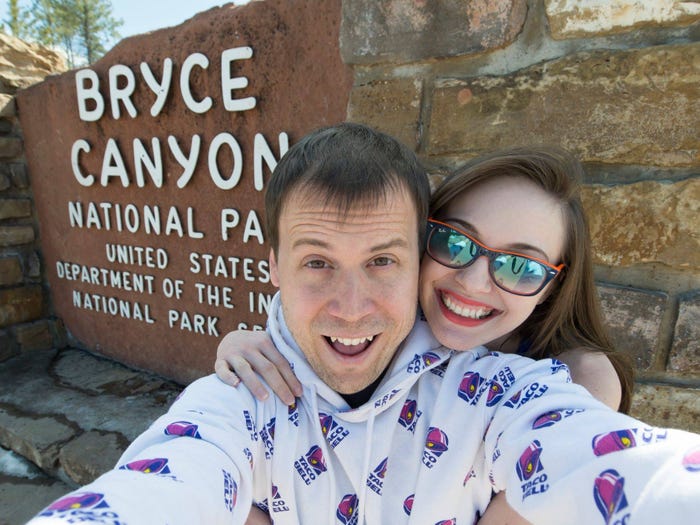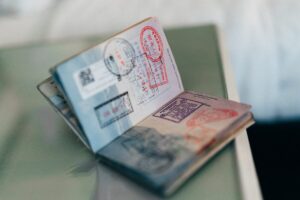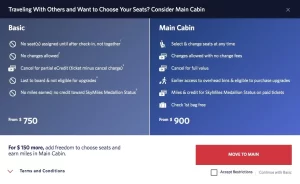A FIRE couple who retired early visited every national park. They shared 6 of their favorites — and 5 to skip.
6 min readA FIRE couple who retired early visited every national park. They shared 6 of their favorites — and 5 to skip.

- Steven and Lauren Keys retired at 29 by saving over 60% of their income and investing early.
- With a net worth of $1.1 million, they visited every state and national park.
- Their favorite is Death Valley, while they weren’t as fond of Hot Springs or Gateway Arch.
Steven and Lauren Keys, now 33 and 34, retired at 29 and have visited every state and national park — managing to grow their wealth while doing so.
Though neither earned more than $90,000 a year while they were working full-time, they saved over 60% of their income, began investing early, and avoided unnecessary purchases, allowing them to travel for much of the year while returning with more money than they started with. On one three-month trip, they returned with $26,000 more despite working just part-time by keeping costs low, getting freebies, and achieving large investment gains.
“We never spend down our savings when on vacation, and we usually get richer in the process,” Steven said.
They’ve explored much of the country, deciding their favorite national parks are in California and Alaska — while their least favorite are in the Midwest.
Achieving financial independence
Steven and Lauren are part of the FIRE community — financial independence, retire early — consisting of people who saved and invested enough to be secure financially and not rely on income from work.
They went to high school together outside Tampa and then attended the University of Florida. Lauren put herself through college thanks to scholarships, grants, and various jobs. Steven had some assistance from his parents and received a tuition scholarship. Both graduated debt-free.
The summer after graduating, they did a road trip across the US, driving from Florida to Alaska with a stop in New York. They slept in their car for much of the 45-day trip and didn’t spend much on food.
After a stint in California, they moved back to Florida, where Steven got a full-ride scholarship for a master’s program in science education. Lauren found a job at a small financial company, and both were making about $40,000 a year. Due to tight budgeting, they saved more than 60% of their income. In two years with both of them working five-figure jobs, they saved over $100,000.
After growing fatigued with full-time employment, they married and took a six-month sabbatical to Hawaii, where they lived frugally. They rented an apartment for six months instead of staying at hotels, bought a cheap car and sold it for more than they paid for it, and did some part-time work. Despite barely working, they returned with over $1,000 more in net worth than they started from part-time work, low-cost purchases, and investments.
They bought their first home — a $71,000 condo in Gainesville — in cash, then job-hopped for a few years until both made about $90,000 a year. By 2019, they were worth about $600,000, and they felt it was time to embark on a seven-month road trip hitting every US national park. Due to their investments and part-time work on the road, the trip cost them nothing on net.
“The best way to save money on any trip is to attack your biggest costs, which are going to be lodging and transportation,” Steven said. “Anywhere that you’re willing to drive to instead of flying, particularly if there are multiple people, that’s going to save you a massive amount of money in terms of airline costs. Another thing is getting away with camping, whether in your vehicle or in a tent or campground or anything like that.”
Lauren retired in 2020 while Steven worked full-time for six months before moving to a part-time arrangement. They moved to a condo by the ocean on Florida’s east coast and continued to grow their investments in low-cost index funds, real-estate holdings, and retirement accounts. Steven has continued freelancing through tutoring while Lauren does part-time social media work.
It’s allowed them to take various one- to three-month vacations over the last four years. Last year, they went on a three-month trip to Australia, after which they came back $26,000 richer. They kept expenses to below $18,000 plus $3,000 in expenses in the US, and they made about $19,000 in freelance income and $28,000 in investment gains. They bought a cheap car on Facebook Marketplace in Australia, which they sold for slightly more than they paid for it, earned free loyalty nights at hotels, cooked many of their meals, and found free museums and concerts.
Their net worth is $1.1 million, and they’re gearing up for a road trip to eastern Canada. They calculated their sweet spot is spending at most $26,000 a year to feel fulfilled without breaking the bank, though they don’t track their expenses or budget.
Favorite — and least favorite — national parks
Steven and Lauren ranked their favorite and least favorite national parks from their travels on factors such as how much the park took their breath away, how many fun things the park had, and how easy it was to find quiet in the park.
“Nothing’s worse than showing up somewhere beautiful, and you can’t get a picture of it without a crowd in the way,” Lauren said. “We’ve been to Yosemite a couple of times, and there are areas where you’re sitting in traffic literally in a national park for an extra 45 minutes.”
Death Valley was their favorite, citing the vast sand dunes of Eureka Valley, the salt flats of Badwater Basin, and the colorful rocks of Artist’s Palette. Despite the crowds, Yosemite ranked second overall, as they noted the waterfalls and granite cliffs are superb.
Hawai’i Volcanoes was their third favorite, as they lived nearby for six months and explored the park’s intricacies. They ranked Hawaii’s Haleakalā, the highest point on Maui, in ninth.
Other parks topping the list include Yellowstone, American Samoa, Carlsbad Caverns, and Canyonlands.
About 41% of the total cost of attending all national parks came from traveling to Alaska, Hawaii, and other American territories. Still, four of their top 10 parks are outside the contiguous US.
They said one of the easiest — and cheapest — places to camp is Alaska, which they’ve driven to three times.
“You don’t really have to pay anything because you can pretty much pull off wherever you want,” Steven said. “Nobody stares if you camp or sleep in your vehicle.”
Their least favorite national park was Hot Springs in Arkansas, which was the first national park they visited. They felt it didn’t live up to the status of “national park,” which they also felt about the Gateway Arch in St. Louis. They also weren’t thrilled by Voyageurs in Minnesota, which didn’t have many activities other than inexpensive boat tours; Guadalupe Mountains in Texas, which had fantastic views but difficult-to-access sites; and Lassen Volcanic in California, which they found peaceful but smelled like “an ugly pot of bubbling sulfur water.”
Best and worst states
The Keys’ top four favorite states are California, Alaska, Hawaii, and Utah.
“In terms of just natural beauty and uniqueness, California has so much diversity,” Steven said. “Northern and Southern California are two completely different places with two completely different awesome experiences.”
Though everyone goes to Oahu, the Big Island in Hawai’i is “super underrated,” Lauren said, due to the scenery and relative calm.
Their home base of Florida didn’t make the top of their top states list, as they viewed the state’s three national parks as less interesting above-ground than many others, though they’re great for scuba or snorkeling.
Their least favorite states included Kansas, Missouri, South Carolina, and New Jersey. They found Kansas rather monotonous with plenty of cornfields, and they thought St. Louis and Kansas City were very congested but didn’t have the same charm as other large cities.
They felt North Dakota, South Dakota, Idaho, and Montana are underrated, as each has some of their favorite national parks, affordable accommodations, and cities with a calmer, suburban feel. Still, they found Mount Rushmore overrated, as they expected it to be larger.
Have you visited every — or most — state or national park? Are you part of the FIRE movement or living by some of its principles? Reach out to this reporter at nsheidlower@businessinsider.com.
Discover more from Slow Travel News
Subscribe to get the latest posts sent to your email.



